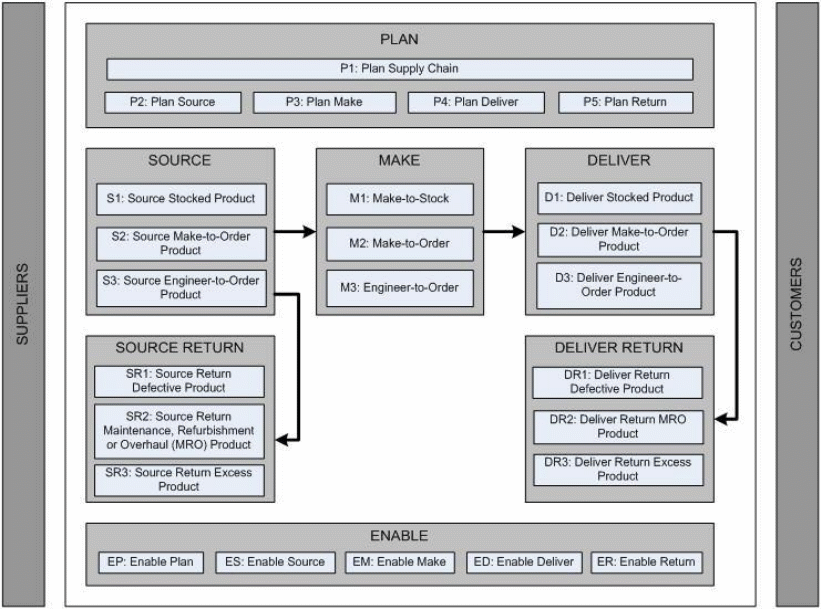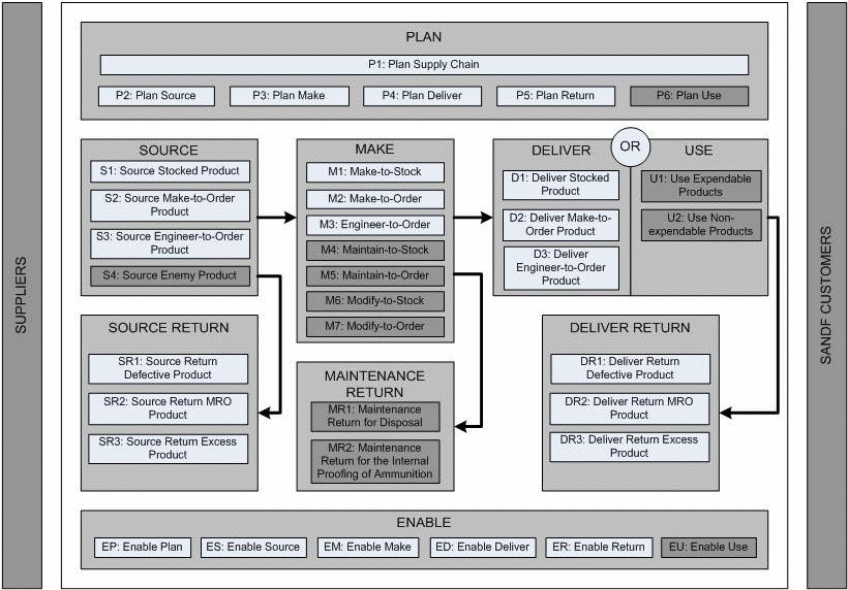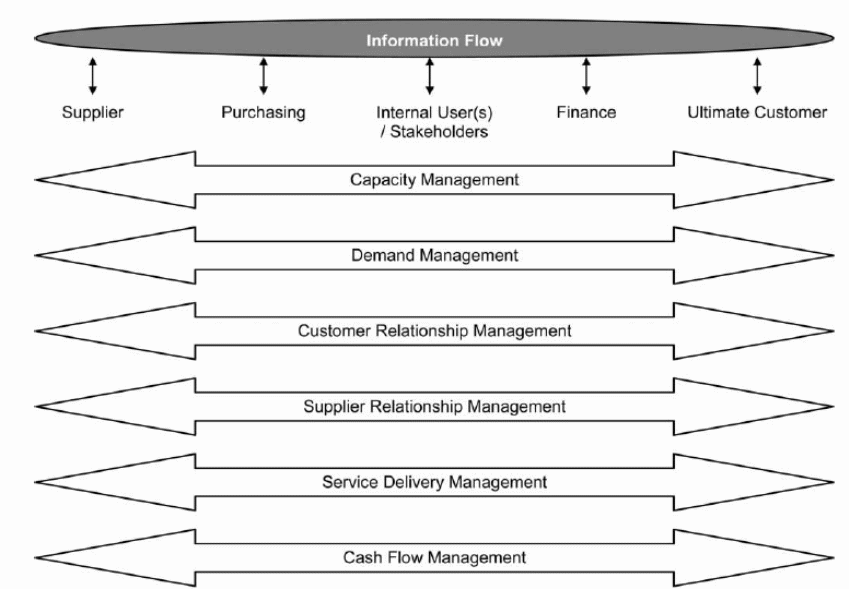Introduction
Traditionally, SCOR (Supply Chain Operations Reference) model was used to analyze commercial activities. The model was employed widely as a tool to aid in the evaluation of the supply chain. The application of the model is dated back to the date when the Supply Chain Council (SCC) generated the model.
In the last few decades, the application of the model has shifted to the analysis of supply chain in the military environment. In that line of thought, the South African National Defense Force (SANDF) decided to adopt the SCOR model together with the SCM (Supply Chain Management) during their improvement project in relation to logistics and supply chain.
The SANDF with CSIR assistance set out to find out and propose methods necessary for the improvement of their inventory, as well as logistics bookkeeping capabilities. The move was guided by suggestion, as well as SCOR model experience. This led to the adoption of the supply chain management practices and SCOR model as a tool of improving the effectiveness of procurement and proper accounting of military inventory. In order to derive a clear understanding of SANDF supply chain, it was necessary to conduct three distinct case studies.
First, the case study seeks to evaluate a single commodity that falls under the ammunition category, and is used by the navy personnel of South Africa. The commodity under analysis in the first case is fused proximity ammunition with distinct feature of 76mm high effect (Jacobs & Chase, 2011, p. 61).
The second case study that was categorized as complex involved the evaluation of a supply chain that involves multiple commodities. In this study an approximately three commodities were under consideration. Such commodities include ammunition, medicine, as well as ration packs.
This study involves a complex analysis of the commodities since its main purpose was to track suppliers and contingents of SANDF. Lastly, the third case study analyzed seeks to ascertain the supply chain of weapon system of SANDF.
The main weapon system applicable in SANDF that were investigated includes helicopters, submarines and armored cars. The SCOR model that was utilized in the analysis of the supply chain of SANDF is classified as v9.0 and represents the eleventh version.
The findings of the case studies maintain that the application of SCOR model in the military activities is incomprehensive since it does not sufficiently capture the supply chain activities of SANDF. As a result, the SCOR model was modified in order to accommodate all the activities of SANDF. The modification involves the expansion of the model to incorporate other aspects that are relevant to the military environment.
SCOR model applications
SCOR model as a technique to aid managers in the day-to-day running of their logistics and supply chain operation sounds like a newly conceived concept but in reality it was developed as early as 1950s and 60s. Supply Chain Council (SCC) first developed the concept.
The concept has received a very warm welcome in different sectors with every manager looking at it as the panacea of their long encountered problems. The approach is believed to be compatible to any industry regardless of its size or market share.
With the changing technologies, environments like economic, social, financial or political, new competitors among others. These changes can only be incorporated in the long-term plan of the business through strategic supply chain management.
There are also other grand strategies some of which has been adopted by commercial environment, it includes; diversifications, mergers and acquisition, concentrated growths, product development, innovation, turnarounds, integration and strategic alliances. It is believed that strategic supply chain management is a recipe to the success and continuous growth of the commercial industry.
With its utilization by many organizations, there has been development of technologically based products. According the council the SCOR model ensures the presence of a supply chain framework that is unique. The framework will facilitate linkage of processes, technologically based features, best practices, metrics, as well.
Through the initiated framework a structure is developed that will unify the factors in order to enhance communication among partners of supply chain. In addition, the framework seeks to improve the efficiency and effectiveness of the supply chain improvement, and management, as well (Lawrence, Klimberg & Miori, 2011, p. 72).
The foremost purpose of the model was to provide a comprehensive explanation concerning the phases that exhibit consumer satisfaction. The structuring of the SCOR model is inclined to five distinct management processes.
The management process incorporated in the model includes Plan (P), Source (S), Make (M), Deliver (D), and Return (R). This represents the building blocks of management processes and it establishes the main features or components that are essential when defining a supply chain.
The SCOR model entails aspects that cover the customers’ communications, tangible material dealings, and market communications. However, the model lacks to cover transactions and marketing, research and development, invention development, as well as consumer support processes (Mangan, Lalwani & Butcher, 2008, p. 69).
The Supply Chain Council can modify the SCOR model in order to accommodate all the necessary activities, for instance, to capture the activities of SANDF. The modification involves the expansion of the model to incorporate other aspects that are relevant to the military environment. An impression of the SCOR model classified as v9.0 and represents the eleventh version is illustrated in Figure 1.

In addition, Table 1 below provides a summary of the past worldwide case studies that depicts the application of the SCOR model. The table structures the case study in a four-headed columnar format. The heading specifications include; application area, SCOR model application, SCOR model extensions and adjustments, and reference.
Table 1: An overview of SCOR model applications.
Despite extensive application of the SCOR model in various distinct industries, as well as supply chain, there is limited literature that explores the application of the SCOR model in the military environment, especially, military supply chain practices.
Problem statement
Based on the documented findings of the three case studies identified in the introduction section, it was established that the original SCOR model is limited in terms of coverage. This implies that the model does not sufficiently capture all the operational activities necessary for an effective and efficient SANDF strategic supply chain.
As such, it is prudent to extend and adjust the existing SCOR model in order to render it applicable in the military environment, especially South Africa National Defense Force (SANDF). In light of this statement, it was necessary to identify the areas that require adjustments, and with the assistance of the SANDF personnel, the SCOR model was modified to incorporate military requirements.
All the military requirements have been considered and will have to be incorporated in the model. The main purpose and ideas of the model will be maintained by being interpreted and applied in the military concepts to fit in its use appropriately. The utilization should be the same and its creation has to be re-modeled only in view of its use.
Objective and aims of the research
- To establish how the SCOR model can be adapted in the military environment
- To portray the application of SCOR model in different industries in the world
- To provide recommendations on how the SCOR model can be applicable in improving supply chain and logistics capabilities
SCOR model in military
The SCOR model that was utilized in the analysis of the supply chain of SANDF is classified as v9.0 and represents the eleventh version. This is illustrated in figure 2 below, and entails an additional management process (USE) making a total of six management processes. These processes are enumerated as; Plan, Source, Make, Deliver, USE, and Return.

Plan
Plan represents the initial management process. The process deals with the entire supply chain planning together other planning activities such as sourcing, production, maintenance, delivery, use, as well as return of merchandise for storage, repairs or discarding.
In light of the above description, supply chain planning, in particular for SANDF encompasses all the operational activities of the military. Plan source captures all the activities that entail sourcing. The other process category Plan Make entails planning activities such as developing, repairs, and adjustment.
Process Categories
Source represents a management process that entails all processes and activities that are undertaken internally or externally while sourcing products from producers. This management process is four-fold and is enumerated as source stocked product (S1), source make-to-order product (S2), source engineer-to-order product (S3) and source enemy product (S4).
The first process category under source management process is source-stocked product (S1). This process explains all activities that are encountered while acquiring products that the SANDF can store to utilize in future. These activities include the acquisition, release, receipt, and conveyance of raw material, services, sub-assemblies, and products. This process is also categorized by five elements such as scheduling, receipt, transfer/usage of products and payment authorization.
The second process category is source make-to-order (S2). This category outlines activities that are performed from order placement up to order confirmation by the supplier. The foremost example for this category is ordering of ration packs. Source engineer-to-order product (S3) is the third process in the source category.
This category describes how the product is designed, product development, and product creation in relation to customers’ requirements. The outcome should exhibit the specifications of the customer. Some of the examples of SANDF that falls in this category are the procurement of armor, submarines, and aircrafts among others.
Source enemy products (S4) represent the final process in this category. This is an adjustment to the original SCOR v9.0 version. This, therefore, represents products acquired by the SANDF from an attacking enemy, and the products are captured in the books so that they can be utilized both in present and future military operations. This process category involves capture, verification, and transfer of products (Coyle, 2009, p. 72).
Make
This is a management process and it takes into consideration all the activities of SANDF that include manufacture, maintenance and modifications of products. This process has been modified in order to accommodate the requirements of SANDF.
The adjustments are in relation to the processes. The original SCOR v9.0 version three processes have been extended to seven processes. The extended process in the model specifically gathers for the maintenance of SANDF products. In addition, it is responsible for product modification in order to extend the shelf life for SANDF products.
The original processes include make-to-stock, make-to-order, and engineer-to-order. The other extended processes include maintain-to-stock, maintain-to-order, modify-to-stock, and modify-to-order. These have to be adhered to as per the policies in place and as per the intentions of its use.
Deliver
This process succeeds other primary processes such as product sourcing, product production, product maintenance or modification. The ultimate process of ensuring that the products are in the disposal of SANDF is delivery to warehouses.
The delivery of the products will provide the system manager with the opportunity of integrating the products into the user system. In this management process category there are no adjustments made on the original SCOR v9.0 version; thus, the process category entails three processes.
Return
This management process describes the activities that occur when a demanding entity return procured products to a supplying entity. The return of the product may serve a number of reasons such as; for substitution, for storage, for revamp and for safeguarding.
Products that are replaced are those considered defective by the demanding entity. Furthermore, this process category captures other activities such as discarding of the products by the supplying entity because they are expired.
In order for the return management process to accommodate all the requirements of a military environment, it is essential for the SCOR model to be adjusted. The adjustment includes the creation of a process category that captures maintenance return for disposal. The other adjustment is in relation to ammunition in terms of internal proofing in a military environment.
Use
This refers to the sixth and the last management process. As per the name, it defines all the activities that describe the utilization of the products by SANDF. The process categories identified in this management process was borrowed from the forth management process (Deliver) as indicated in the SCOR model classified as v9.0 and is referred to as the eleventh version.
The insertion of this additional process was guided by facts, as well as experiences that are encountered when SANDF engage in military operations. Such operations trigger certain activities particularly in the supply chain. For instance, vehicles used in the operation need to be maintained, whereas, ammunitions needs replacement after the operation. This is to ensure a continued high quality delivery. It gives no room to any ill-informed issues that may arise. Ammunitions that have to be replaced are far much important and a management of the same is important to ensure its correct use or storage (Vanany, Suwignjo & Yulianto, 2005, p.67).

SANDF supply chain strategy
SANDF supply chain strategy is characterized by looking in, looking out and looking ahead. ‘Looking in’ means critically reviewing and intensifying systems and structures of the military department. This is for managing finances, personnel and other resources. ‘Looking out’ implies discovering away from the boundaries of the military department to set viable objectives, recognize key stakeholders and put together constituencies for change.
Lastly, “Looking ahead” involves bonding the military policy with structures and resources to arrive at the policy goals at the same time as monitoring military progress and adjusting your approach as needed. These strategies are necessary and must be implemented. The strategies are the best for this SANDF supply chain. The management should prioritize the strategy implementation in order to provide adequately for its operations.
Conclusion
Concisely, the South African National Defense Force (SANDF) should adopt the SCOR model together with the SCM (Supply Chain Management) during their improvement project in relation to logistics and supply chain. Briefly, for any SCOR model to be successful at the procurement of products and services in any military environment, the strategic supply chain must fully link with the goals and objectives of the SANDF.
Management must be responsible in transmitting their organization strategy to all their personnel, as well as stressing on the importance of meeting the goals of the strategic supply chain. The military department should understand the immense role that the extended ArmsSCOR model play in their day-to-day supply chain execution.
This will enable them build up supply chain network that are effective for their products and services. There is a call for military department that is integrated. This strategy will have immense contribution to efforts done by department in relation to their supply chain orientations. It will also facilitate an easier and quick project implementation and execution.
Military environment can only recognize effective supply chain network if they regularly conduct an on-the-job training for their personnel. The military personnel should be encouraged to attend training and retraining on regular and continuous basis. This will ensure that they acquire up to date knowledge and skills hence guaranteeing successful implementation of supply chain network. The personnel will gain skills and knowledge on military environment analysis as well as strategic supply chain.
In addition, SCOR model in relation to management processes activities and products entails the process of looking into the current and future procurement environment, originating military goals and objectives, creating, implementing as well as controlling decisions geared at accomplishment of objectives.
The research leads to the conclusion that adapting a modified SCOR model in the military environment is recommended for SANDF, hence guaranteeing their efficiency and effective of the supply chain. Therefore, e-government department is encouraged to practice the use of adapted SCOR model in their procurement orientations with rigor. This will facilitate the achievement of sustainable competitive advantage to ensure that their desired procurements are executed properly.
References
Coyle, JJ 2011, Transportation: a supply chain perspective, 7th edn. South-Western Cengage Learning, Australia.
Coyle, JJ 2009, Supply chain management: a logistics perspective, South-Western Cengage Learning, Mason.
Ellram, LM, Tate, WL, & Billinton, C 2004, ‘Understanding and Managing the Services Supply Chain’, The Journal of Supply Chain Management, Vol. 40, no. 4, pp. 17 – 32.
Hwang, YD, Lin, YC, & Jung, L 2008, ‘The performance evaluation of SCOR sourcing process–The case study of Taiwan’s TFT-LCD industry’, International Journal of Production Economics, Vol. 115, no. 3, pp. 411–423.
Jacobs, FR & Chase, RB 2011, Operations and supply chain management, 13th edn. McGraw-Hill Irwin, New York.
Lawrence, KD, Klimberg, RK & Miori, V 2011, The supply chain in manufacturing, distribution, and transportation: modeling, optimization, and applications, CRC Press, Boca Raton.
Mangan, J, Lalwani, C & Butcher, T 2008, Global logistics and supply chain Management, John Wiley & Sons, Chichester.
Russel, DM, Ruamsook, K & Thomchick, EA 2009, ‘Ethanol and the Petroleum Supply Chain of the Future: Five Strategic Priorities of Integration’, Transportation Journal, Vol. 48, no. 1, pp. 5–22.
Schmitz, P 2007, The use of supply chains and supply chain management to improve the efficiency and effectiveness of GIS units, University of Johannesburg, South Africa.
Vanany, I, Suwignjo, P & Yulianto, D 2005, ‘Design of Supply Chain Performance Measurement System for Lamp Industry’, 1st International Conference on Operations and Supply Chain Management, Bali, Indonesia